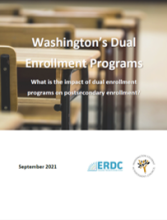Washington invests heavily in Dual Enrollment (DE) programs, with over $150 million spent in 2017 alone. The goal of this investment is to improve systemic inequities and improve postsecondary enrollment rates across the state. While there has been some preliminary evidence suggesting that DE may be successful in those goals, there has not yet been a systematic study examining the effectiveness of these programs after controlling for other factors that also impact postsecondary enrollment, such as demographics, family income, and standardized test scores.
In this report we analyze DE data from the 2017 class of Washington graduating seniors to estimate the impacts of DE on postsecondary enrollment after controlling for a wide range of confounding factors. Part of the rationale for the project was to demonstrate that aggregate data could be effective in its use to develop rigorous analyses. Generally, individualized record-level data allows for a richer analysis and ability to examine intersectionality and more specific outcomes. But in many cases, aggregate data is sufficient to perform a rigorous analysis that can estimate a program’s effect. This technical discussion paper details how aggregate data was used to estimate the impact of dual enrollment on postsecondary enrollment for Washington students.


